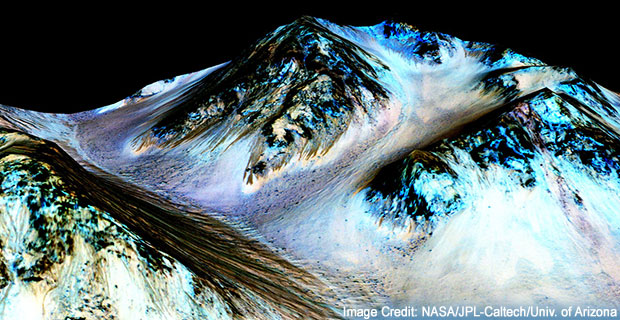Dark, narrow streaks going downhill at four locations on Mars are evidence of water flowing on the planet, NASA confirmed Monday.
Called “recurring slope lineae,” the streaks are approximately the length of a football field, according to NASA’s Jet Propulsion Laboratory. They are believed to have been formed by the seasonal flow of water.
Lujendra Ojha of the Georgia Institute of Technology noticed these lineae as an undergraduate student at the University of Arizona in 2010. He and seven coauthors wrote a report on the research, which was published Monday in the journal Nature Geoscience.
All four locations, including the walls of the Garni and Hale craters, show evidence of hydrated salts, most likely magnesium perchlorate, magnesium chlorate, and sodium perchlorate, Ojha wrote.
The findings strongly support the team’s hypothesis that recurring slope lineae form as a result of current water activity on Mars, he said.
“They’re likely 95 percent correct,” said William Newman, a professor of earth and space sciences at UCLA.
“We know there’s water in [Mars’] polar caps — that’s irrefutable — so the picture they paint is plausible,” he told TechNewsWorld.
Figuring Out the Proof
Ojha noticed back in 2010 that the lineae appeared during Mars’ warm seasons, when temperatures were above -23 degrees Celsius, and seemed to indicate the downhill flow of some liquid. They would fade in cooler seasons.
NASA’s Mars Reconnaissance Orbiter, which is equipped with the High Resolution Imaging Science Experiment camera, made the initial observations. HiRISE observations have documented recurring slope lineae at dozens of sites on Mars, NASA said.
Ojha’s study pairs HiRISE observations with mineral mapping by the Compact Reconnaissance Imaging Spectrometer for Mars on the Mars Reconnaissance Orbiter.
The researchers found the hydrated salts only when the seasonal features were widest, Ojha said, suggesting that either the dark streaks themselves or a process that formed them were the source of the hydration.
Where’s the Water Coming From?
Mars’ atmosphere consists of about 95.3 percent carbon dioxide and 2.7 percent nitrogen. Water is a combination of hydrogen and oxygen, which raises the question of where the water could come from.
Perchlorate salts are powerful oxidizing agents, which would explain how the oxygen in the carbon dioxide might be freed to combine with hydrogen — but where’s the hydrogen?
Hydrogen “exists as a trace element, but it’s highly reactive and would likely bond to any free oxygen to form water,” said Mike Jude, a research manager at Frost & Sullivan.
“Even Earth has a hard time retaining free hydrogen,” he told TechNewsWorld.
The major source of water in the inner solar system is comets, and Mars could have retained “a significant fraction” of that water, UCLA’s Newman speculated.
Daily temperature changes are severe on Mars and could cause liquids to freeze and crack the surface, creating more places for the liquid to collect, as happens in alpine terrains on Earth, he said.
The Meaning of Water
The existence of water posits life on Mars, although other requirements would have to be fulfilled.
Still, a non-oxygen-breathing life form could well exist on Mars.
Here on Earth, scientists in 2010 discovered three anoxic life forms, meaning life forms that don’t need oxygen to live. They belong to the phylum Loricifera.
Further, just what passes for water on Mars has yet to be determined.
While explanations for the lineae revolve around water, “the nature of the water involved is subject to some debate,” Frost’s Jude said.
Whether that will impact any native life forms on Mars, and how, remains to be seen.























































